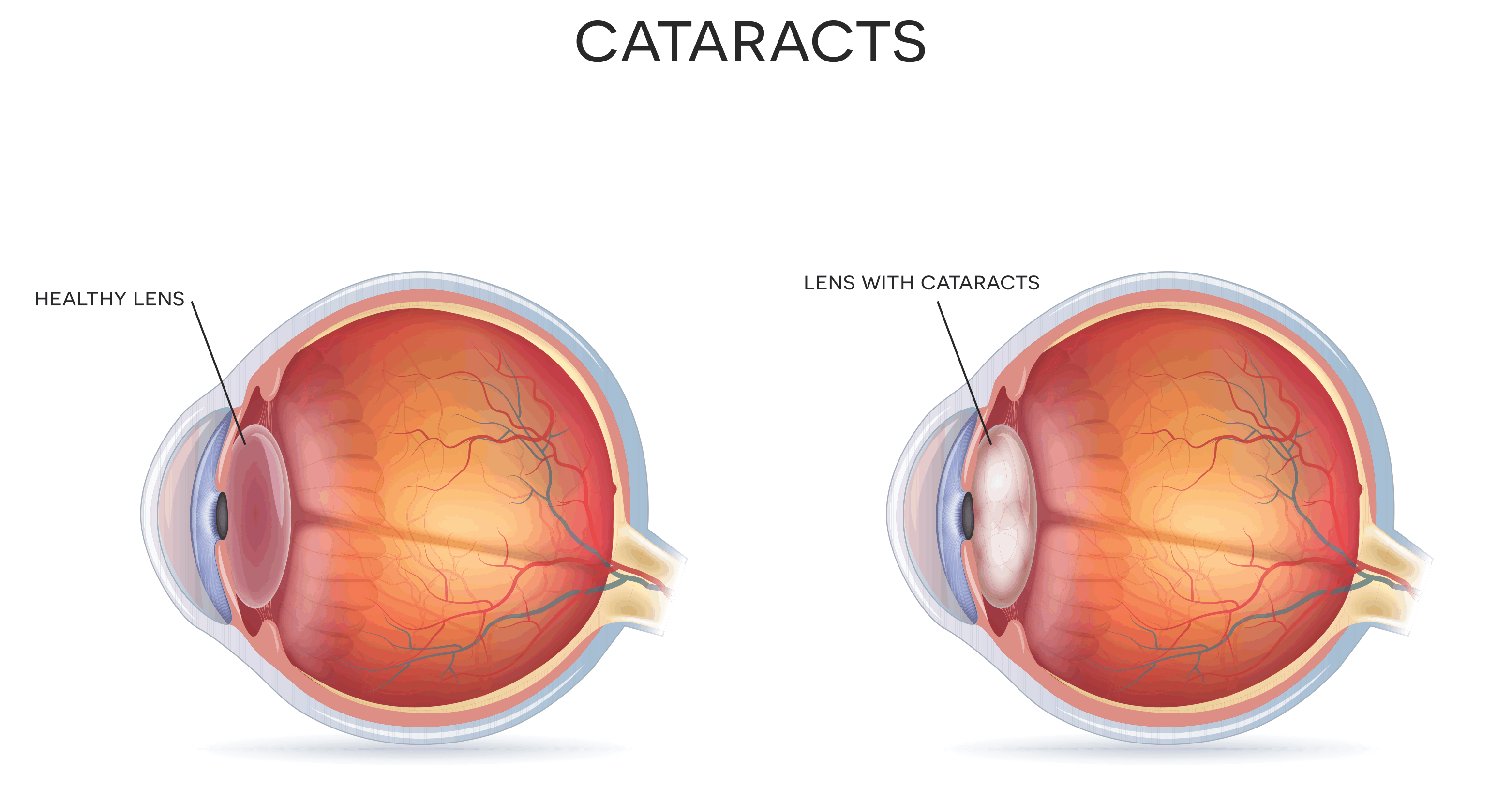Cataracts
Cataracts most commonly affect people over the age of 60. In New Zealand, they are a leading cause of vision loss in older adults. Cataracts tend to develop over a number of years and at their early mild stages, they may not produce any symptoms at all. Without treatment (cataract surgery), cataracts may eventually lead to complete blindness.

What is a cataract?
A cataract is the clouding of the lens inside the eye which causes decreased light reaching the retina and results in a decrease in vision. The lens is located behind your iris inside your eye.
Cataracts can affect different areas of the lens and can be classified accordingly. The location and extent of the cataract also determines the extent of the vision impairment e.g. if the centre of the lens is affected, vision may be significantly impaired, however, if the edges of the lens are affected, vision impairment may be barely noticeable.
Cataracts can affect one eye at a time or both eyes at the same time.
What causes cataracts?
In New Zealand, the most common cause of cataracts is ageing. The lens is made up protein and water. The proteins are arranged in a precise way that keeps the lens clear and lets light pass through to the back of the eye.
As people age, some of these proteins may clump together and start to cloud a small area of the lens. This is called a cataract, and over time, it may grow larger and cloud more of the lens, making it harder to see.
Ultraviolet light is thought to play a role in the development of these changes; however, cataracts can occur for a variety of reasons. The different types of cataracts include:
Common causes of cataracts |
|
| Age-related cataracts | Mainly occur after 60 years of age. |
| Secondary cataracts | Occur as the result of another medical condition such as diabetes, an inflammatory eye condition such as uveitis, or an inflammatory skin condition such as eczema. |
| Traumatic cataracts | Occur as the result of an injury to the eye or lens. |
| Congenital cataracts | Are present at birth or develop in early childhood. They may be caused by an illness or infection in the mother during pregnancy, or as the result of a genetic defect. |
| Toxic Cataracts | Can result from chemical toxicity or long-term use of some medications, such as corticosteroids (eg: prednisone). |
Signs and symptoms of cataracts
The symptoms experienced by those with cataracts are highly dependent on the location and severity of the cataracts. In some early stages, there may be no noticeable symptoms or vision changes in the early stages of a cataract. Symptoms of cataracts can include:
-
Blurring of vision – you may notice a film or haze in your everyday vision. This makes images look cloudy, blurry, fuzzy, foggy or filmy.
-
Veiling Glare – increased difficulty with bright lights due to the cataract scattering the lights e.g. headlights when driving and bright sunlight.
-
Change in colour vision – colours may appear duller than before.
-
Frequent changes in spectacle prescription – changes in the protein configuration in the lens can cause a significant change to your glasses prescription. New spectacles may help initially but as the cataract progresses, an increase of prescription will not provide any improvement to your sight.
-
Double vision when viewing through one eye – this occurs when two clear portions of the lens letting images through the lens to the retina, causing the perception of two images.
- A noticeable cloudiness in the pupil.
Are cataracts painful?
Cataracts are not usually painful unless they are causing a secondary issue like angle closure glaucoma. In that case, the enlargement of the lens as the cataract process advances can cause this angle closure glaucoma, which may cause eye pain and headaches.
Can you prevent cataracts?
Wearing sunglasses and a hat to block UV sunlight may help to slow down the progression of cataract. Try to stop smoking if you are a smoker. Some researchers recommend consuming green leafy vegetables, fruit and other foods with antioxidants.
Certain medications, such as corticosteroids, are being taken on a long-term basis, it is recommended that the eyes are checked regularly for signs of cataract development.
How do you diagnose cataracts?
If cataracts are suspected, a referral to an eye specialist is usually recommended. The eye specialist may carry out more detailed examinations of the eye and vision in order to determine the exact location and extent of the cataracts. They will then recommend appropriate treatment.
Cataracts are detected through a comprehensive eye exam that includes:
- Visual acuity test - This eye chart test measures how well you see at various distances.
- Dilated eye exam - Drops are placed in your eyes to widen, or dilate, the pupils. Your eye care professional uses a special magnifying lens to examine your retina and optic nerve for signs of damage and other eye problems. After the exam, your close-up vision may remain blurred for several hours.
How are cataracts treated?
The symptoms of early cataracts may be improved with new prescription glasses, better lighting or effective sunglasses. Once cataracts progress and impair vision to such an extent that daily activities are affected, surgery is the only effective treatment.
The Wellington Eye Centre does not currently offer cataract surgery, if you are looking for this we recommend asking your Optometrist for a referral to an appropriate specialist.
Unfortunately the presence of cataracts can make you unsuitable for laser eye surgery depending on the type and extent of them. You can read more about this in our blog about the differences between laser eye surgery and cataract surgery.
